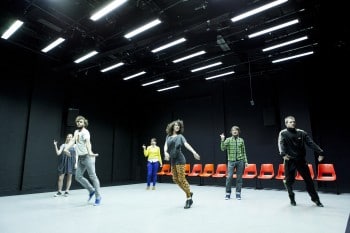Dance Massive – In conversation with Lucy Guerin

Photo: Brett Boardman
Melbourne’s contemporary dance scene is madly gearing up for Dance Massive 2013 – a jam-packed festival showcasing new works from emerging and established dance and theatre makers across this wonderful city. Bethany Simons recently stopped by Lucy Guerin Inc. to sit in on rehearsals and chat with Guerin herself about the creative process for Conversation Piece and her interest in extending the art of contemporary dance.
Have you ever had a conversation and then replayed it in your head over and over again? Conversation Piece takes this idea and dances with it, among other things. Featuring three dancers, three actors and six iPhones, this characteristically quirky, charming and thought-provoking work takes a spontaneous live encounter and turns it into a structural score where dance and dialogue meet.
Originally approached by Sydney’s Belvoir theatre to come up with an idea that would make sense for collaboration between the two organisations, Guerin was immediately interested in a crossing over of art forms.
“Ralph Myers contacted me to see if I would like to do a development. I was interested in finding an idea for a work with dancing and acting. I selected my dancers and Belvoir were able to help me find the actors. I specified that I wanted to work with actors who were very happy to be part of an open process as we didn’t necessarily know where it was heading.”
Guerin admits to going into the first development with no preconceived ideas, merely hoping that they would all emerge at the end with a strong idea of what the show was and where it would go.
“Generally I always go in with an idea, but I find that the real content comes out of the day to day process of working with the performers. This time I thought, ‘I’m really going to go in there with nothing’. It was quite scary, and I wasn’t quite sure if (Belvoir) would understand that as a concept.”
Not being as familiar with the theatre world, Guerin was given access to the range of in-house creatives at Belvoir such as dramaturges and directors.
“I had other eyes from that side of the fence, so to speak, which was great. For the first development director Simon Stone worked with us. We talked a lot about what the script was going to be. In the end, I didn’t want to have a script because it gives the piece a particular feel when the words are pre-scripted. Eamon Flack also offered feedback. I don’t generally work with a dramaturge, but I always appreciate having people come in.”
A key element of the development was being able to rely on the actors and dancers to bring something to the space, not just stand there and wait to be directed; a process that calls for well-rounded, thinking artists.
“It’s quite an ask to have people come into a process where everything is unknown. I was very lucky with the casting choices because they all really embraced it.”
Many dancers can act, but not all actors can dance. Guerin embraced this and worked with the actors to create a physical score.
“It’s a great cast. For the dancers it is quite technical and for the actors it is also movement based. Some of it is more ‘attempts’ to dance because the actors can’t necessarily dance in the way the dancers can dance, but all of them are quite physically engaged actors.”
The premise of the show is an improvised eight-minute conversation for three dancers that is recorded on iPhones and then treated in a number of different ways. The day I was there, the dancers covered topics as varied as skin problems, beach holidays and busking magicians.
“It becomes the script for the show. The conversation itself is completely different each time; the dancers themselves don’t know what they’re going to say when they go out there, and there’s no briefing. It’s really undirected, deliberately. The structure of the show itself is really set and then things happen inside of that that are free. The dancing is choreographed, which works in terms of the show, but in terms of the concept of the piece, I’ve wondered whether it also should have been improvised?”
One would think that spontaneous conversation alone could be a dangerous choice; what if it’s boring?
“I did used to have that fear. But sometimes it is boring and repetitive and that’s part of it. It’s only eight minutes, and luckily, it’s the first eight minutes of the show. They say the first five minutes is free. Sometimes that very boring text, when it comes back in other parts of the show, can reveal other dimensions and meanings through what other people are doing. There are a lot of chance events happening in conjunction with the text that do change every night.”
Sitting in on rehearsal I discovered that iPhones are an integral part of the work. They generate soundtrack elements and are the devices through which people communicate and receive their information. I couldn’t help thinking how this technology has changed the way we converse in everyday life.
“It definitely is a commentary in the show, but it didn’t start like that. We just needed to use something to record in rehearsal and thought, ‘Let’s use our iPhones for now’. Because the work is about the difficulties of communication or isolation this seemed a perfect medium.”
Guerin wants to continue challenging and extending contemporary dance as an art form by finding revelations in the visual, emotional and physical.
“My choreography process changes, depending on what the work is. I am very old school in that I make movement on my own body that the dancers then learn. Sometimes I get input from the dancers or ask them to execute certain physical tasks in relation to instruction, for example improvising or dancing to the patterns of speech. For me there are infinite ways to generate movement.
“Apart from pushing my own artistic practice, for me the purpose of all my work is to affect the audience and it could be in a number of ways. Ideally, in my perfect world, the audience would have some kind of recognition beyond what they knew when they walked into the theatre.”
Having been developed in and performed for a Sydney theatre crowd at Belvoir, Dance Massive 2013 is the first time Conversation Piece will have been performed for Melbourne audiences.
“There are a lot of relationships between dancing and text, but this work is a conversation between dancing and acting as art forms. I think people often have difficulty reading or understanding contemporary dance. What usually happens is that dance tries to be understood through language. There are a lot of ways you can read dance and it’s not just through a linear narrative description, which I think a lot of people are looking for. I wanted to explore the way that physicality can have a resonance with an audience, and then the way that words do. They’re very different.
“I’m really hoping that Dance Massive will draw people from outside of dance, because I think it’s a really exciting program – it’s a good thing to be a part of.”
Conversation Piece will run from 19 – 24 March as part of the Dance Massive program.
For bookings and full program details visit dancemassive.com

